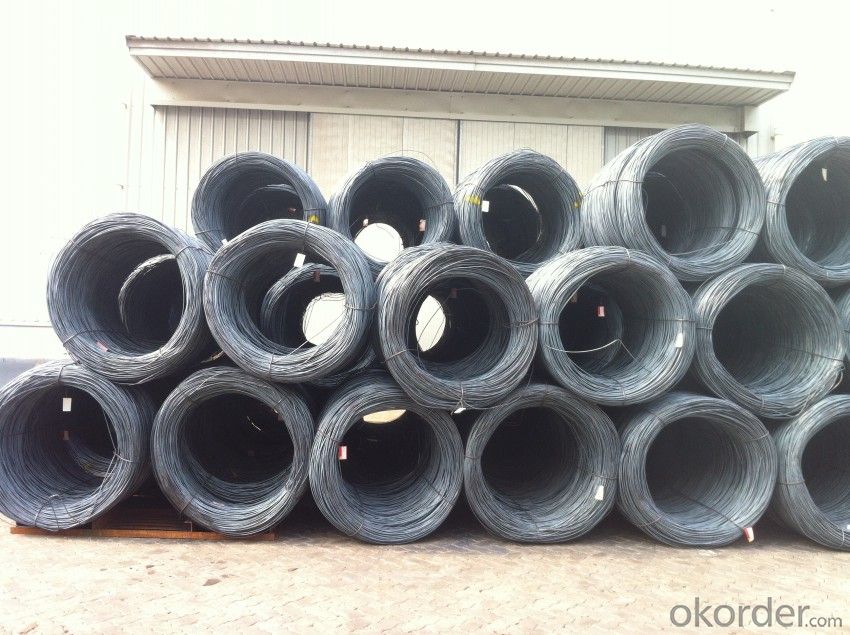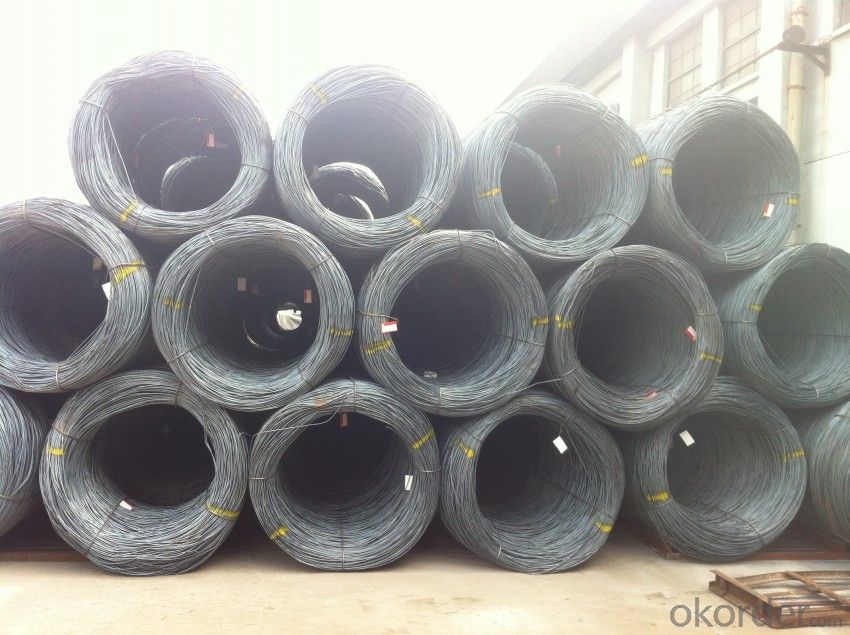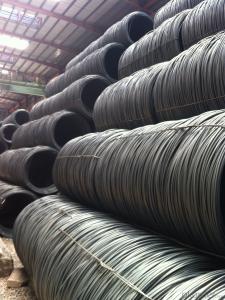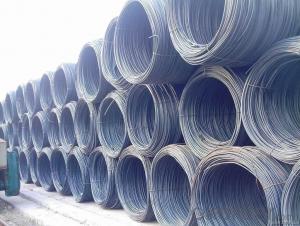Hot Rolled Low Canbon Wire Rods with Good Price
- Loading Port:
- Tianjin
- Payment Terms:
- TT OR LC
- Min Order Qty:
- 25 m.t
- Supply Capability:
- 10000 m.t/month
OKorder Service Pledge
OKorder Financial Service
You Might Also Like
OKorder is offering wire rods at great prices with worldwide shipping. Our supplier is a world-class manufacturer of steel, with our products utilized the world over. OKorder annually supplies products to European, North American and Asian markets. We provide quotations within 24 hours of receiving an inquiry and guarantee competitive prices.
Product Applications:
After hot-rolled the products shaped into coil and delivery as finished product, including round, square,rectangular, hexagonal and so on. Since most of the products are round, it is generally called wire rod. Carbon steel wire rod is widely used in construction and manufacturing. Carbon steel wire rod is mainly used for reinforcement of reinforced concrete and welded structure or reprocessed (roberts , nail, etc.) materials, especially used to produce wire drawing, welding electrode, nails, spring, electronic, precise machinery parts and so on.
Product Advantages:
OKorder's Wire rods are durable, strong, and resist corrosion.
Main Product Features:
· Premium quality
· Prompt delivery & seaworthy packing (30 days after receiving deposit)
· Corrosion resistance
· Can be recycled and reused
· Mill test certification
· Professional Service
· Competitive pricing
Product Specifications:
Manufacture: Hot rolled
Grade: SAE1006-SAE1018
Certificates: ISO, SGS, BV, CIQ
Packaging: Export packing, nude packing, in coils
Grade | Chemical Composition (%) | |||||
C | Mn | S | P | Si | B | |
SAE1008B | 0.10max | 0.32max | 0.045max | 0.040max | 0.30max | 0.0008min |
Mechanical properties | ||||||
Yield strength(N/mm2) | Tensile strength(N/mm2) | Elongation (%) | ||||
≥195 | 350-380 | ≥32 | ||||
FAQ:
Q1: Why buy Materials & Equipment from OKorder.com?
A1: All products offered byOKorder.com are carefully selected from China's most reliable manufacturing enterprises. Through its ISO certifications, OKorder.com adheres to the highest standards and a commitment to supply chain safety and customer satisfaction.
Q2: How do we guarantee the quality of our products?
A2: We have established an advanced quality management system which conducts strict quality tests at every step, from raw materials to the final product. At the same time, we provide extensive follow-up service assurances as required.
Q3: How soon can we receive the product after purchase?
A3: Within three days of placing an order, we will begin production. The specific shipping date is dependent upon international and government factors, but is typically 7 to 10 workdays.
Q4: Can stainless steel rust?
A4: Stainless does not "rust" as you think of regular steel rusting with a red oxide on the surface that flakes off. If you see red rust it is probably due to some iron particles that have contaminated the surface of the stainless steel and it is these iron particles that are rusting. Look at the source of the rusting and see if you can remove it from the surface.
Images:


- Q:What are the different types of steel wire rod finishes for aesthetic purposes?
- There are various types of steel wire rod finishes that are used for aesthetic purposes. Some common ones include polished, brushed, matte, and textured finishes. These finishes enhance the visual appeal of the steel wire rod and can be chosen based on personal preference or the desired aesthetic outcome.
- Q:What are the factors affecting the price of steel wire rods?
- There are several factors that can affect the price of steel wire rods. These include the cost of raw materials such as iron ore and scrap metal, the demand and supply dynamics in the market, fluctuations in currency exchange rates, government policies and regulations, and the overall economic conditions. Additionally, factors such as production costs, energy prices, and transportation costs can also impact the price of steel wire rods.
- Q:What are the major players in the steel wire rod industry?
- Some of the major players in the steel wire rod industry include ArcelorMittal, Nippon Steel Corporation, Tata Steel, EVRAZ, and Gerdau. These companies have a significant global presence and play a key role in the production and supply of steel wire rods.
- Q:What are the main factors influencing the choice of steel wire rod manufacturer?
- The main factors influencing the choice of steel wire rod manufacturer include the quality and consistency of the product, cost competitiveness, production capacity and reliability, adherence to industry standards and regulations, reputation and track record, technological capabilities, availability of customized products, and strong customer service and support.
- Q:What are the different chemical analysis techniques for steel wire rod?
- There are several different chemical analysis techniques that can be used to analyze steel wire rod. These techniques are important in determining the composition and quality of the steel. One of the most common techniques is optical emission spectroscopy (OES). OES involves heating the sample to a high temperature and then analyzing the light emitted by the elements present in the steel. This technique can provide information about the concentrations of various elements, such as carbon, manganese, and sulfur, in the steel wire rod. Another technique that can be used is X-ray fluorescence (XRF) spectroscopy. XRF involves bombarding the sample with X-rays and then analyzing the fluorescent X-rays that are emitted. This technique can provide information about the elemental composition of the steel, including both major and trace elements. Inductively coupled plasma (ICP) spectroscopy is another commonly used technique for chemical analysis. ICP involves ionizing the elements in the steel sample and then analyzing the resulting emission spectra. This technique can provide information about the concentrations of various elements, including both metals and non-metals. Other techniques that can be used for chemical analysis of steel wire rod include atomic absorption spectroscopy (AAS), which measures the absorption of light by the sample, and mass spectrometry, which can provide information about the isotopic composition of the elements present in the steel. Overall, these chemical analysis techniques play a crucial role in ensuring the quality and integrity of steel wire rod by providing information about its elemental composition and impurity levels.
- Q:How is steel wire rod used in the automotive industry?
- Steel wire rod is commonly used in the automotive industry for various applications. It is primarily utilized in the production of automotive components such as springs, cables, and tires. The high strength and durability of steel wire rod make it ideal for reinforcing parts that require resilience and resistance to wear and tear. Additionally, steel wire rod is also used in the manufacturing of safety belts, which rely on its tensile strength to provide security to passengers.
- Q:What are the different cleanliness testing methods for steel wire rod?
- In the industry, multiple cleanliness testing methods are commonly employed to assess the quality of steel wire rods. These methods aid in determining the presence of impurities and contaminants on the surface, ensuring its suitability for various applications. Some of the cleanliness testing methods for steel wire rods are as follows: 1. Visual Inspection: This method is the simplest and most fundamental. It involves visually examining the surface of the wire rod for visible impurities such as scale, rust, or foreign particles. 2. Magnetic Particle Inspection (MPI): MPI is a non-destructive testing method that utilizes magnetic fields and iron particles to detect surface and near-surface defects on the wire rod. It is particularly effective in identifying cracks, seams, or other imperfections that may compromise the integrity of the wire rod. 3. Eddy Current Testing: Eddy current testing is another non-destructive method that employs electromagnetic induction to detect surface defects and variations in conductivity. It can identify defects such as cracks, pits, or variations in material composition that may affect the quality and performance of the wire rod. 4. Ultrasonic Testing: Ultrasonic testing entails the utilization of high-frequency sound waves to detect internal and surface defects in the wire rod. It can uncover flaws such as voids, inclusions, or discontinuities that may weaken the structural integrity of the wire rod. 5. Chemical Analysis: Chemical analysis involves the use of various laboratory techniques to determine the chemical composition of the wire rod. It can identify impurities, such as sulfur, phosphorus, or other elements that may impact the mechanical properties and corrosion resistance of the wire rod. 6. Microscopic Examination: Microscopic examination involves magnifying the surface of the wire rod using optical or electron microscopes and analyzing it at a microscopic level. This method aids in identifying surface defects, inclusions, or other anomalies that may affect the performance of the wire rod. By utilizing these diverse cleanliness testing methods for steel wire rods, manufacturers and end-users can ensure that the material meets the required cleanliness standards and specifications, guaranteeing its quality and suitability for its intended use.
- Q:What are the different cutting methods for steel wire rod?
- There are several different cutting methods for steel wire rod, including shearing, sawing, grinding, and laser cutting. Shearing involves using a cutting tool to separate the wire rod at a specific point, while sawing utilizes a saw blade to cut through the rod. Grinding involves using an abrasive wheel to remove material and cut through the wire rod. Laser cutting uses a high-powered laser beam to melt and vaporize the wire rod, creating a precise cut. Each method has its own advantages and is chosen based on the specific requirements of the application.
- Q:What are the common industry certifications for steel wire rod?
- Some common industry certifications for steel wire rod include ISO 9001:2015 for quality management systems, ISO 14001:2015 for environmental management systems, and OHSAS 18001:2007 for occupational health and safety management systems. Additionally, certifications such as ASTM A510/A510M-18, ASTM A370-20, and ASTM A510/A510M-18a may be relevant for specific applications and standards compliance within the steel wire rod industry.
- Q:How does the dimensional accuracy of steel wire rod vary with different heat treatment processes?
- The dimensional accuracy of steel wire rod can vary with different heat treatment processes. Heat treatment involves subjecting the steel wire rod to controlled heating and cooling processes to alter its physical and mechanical properties. One common heat treatment process for steel wire rod is annealing. During annealing, the wire rod is heated to a specific temperature and then slowly cooled. This process helps to relieve internal stresses, improve ductility, and refine the grain structure of the steel. In terms of dimensional accuracy, annealing can help reduce internal stresses that may cause distortion or warping in the wire rod, resulting in improved dimensional stability. Another heat treatment process is quenching and tempering. Quenching involves rapidly cooling the wire rod after heating it to a high temperature, typically in a liquid such as oil or water. This rapid cooling process hardens the steel, making it stronger but also more brittle. To improve the toughness and reduce the brittleness, the wire rod is then tempered by reheating it to a lower temperature and then slowly cooling it. The dimensional accuracy may be affected during the quenching process due to rapid cooling, which can cause distortion or warping. However, tempering helps to reduce the brittleness and minimize the distortion, resulting in improved dimensional accuracy. Furthermore, other heat treatment processes such as normalizing and stress relieving can also influence the dimensional accuracy of steel wire rod. Normalizing involves heating the wire rod to a specific temperature and then allowing it to cool in still air. This process helps to refine the grain structure and improve the mechanical properties of the steel. Stress relieving, on the other hand, involves heating the wire rod to a temperature below the critical range and then slowly cooling it, which helps to reduce internal stresses. Both normalizing and stress relieving can contribute to improved dimensional accuracy by minimizing distortions or warping. In summary, the dimensional accuracy of steel wire rod can vary with different heat treatment processes. Annealing, quenching and tempering, normalizing, and stress relieving are some of the commonly used heat treatment processes that can impact the dimensional accuracy. The choice of the heat treatment process should be carefully considered to achieve the desired dimensional accuracy while also meeting the required mechanical properties of the steel wire rod.
1. Manufacturer Overview |
|
|---|---|
| Location | |
| Year Established | |
| Annual Output Value | |
| Main Markets | |
| Company Certifications | |
2. Manufacturer Certificates |
|
|---|---|
| a) Certification Name | |
| Range | |
| Reference | |
| Validity Period | |
3. Manufacturer Capability |
|
|---|---|
| a)Trade Capacity | |
| Nearest Port | |
| Export Percentage | |
| No.of Employees in Trade Department | |
| Language Spoken: | |
| b)Factory Information | |
| Factory Size: | |
| No. of Production Lines | |
| Contract Manufacturing | |
| Product Price Range | |
Send your message to us
Hot Rolled Low Canbon Wire Rods with Good Price
- Loading Port:
- Tianjin
- Payment Terms:
- TT OR LC
- Min Order Qty:
- 25 m.t
- Supply Capability:
- 10000 m.t/month
OKorder Service Pledge
OKorder Financial Service
Similar products
New products
Hot products
Related keywords



























